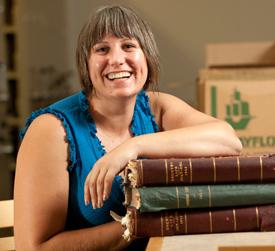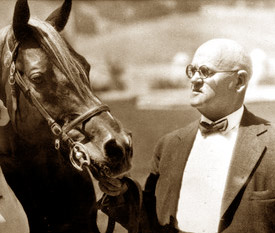Rich history of the Arabian horse.
from www.horsetalk.co.nz
 Katherine Staab spends her days immersed in the rich history of the Arabian horse. Similar to how an archaeologist feels after discovering new artifacts, Staab is excitedly searching and sorting through the Arabian Horse Collection of American philanthropist W.K. Kellogg.
Katherine Staab spends her days immersed in the rich history of the Arabian horse. Similar to how an archaeologist feels after discovering new artifacts, Staab is excitedly searching and sorting through the Arabian Horse Collection of American philanthropist W.K. Kellogg.
“The sensory experience is thrilling,” says Staab, the newly hired Arabian horse subject specialist working in the University Library at Cal Poly Pomona, the university of 20,000 students which now stands on the California site of Kellogg’s ranch. “The smell of the leather and old paper, as well as the feel of the pages and bindings, provides a real sense of history and romance that makes me feel a bit like Indiana Jones,” Staab says.
Staab, who came to Cal Poly Pomona in May from Connecticut, where she was living on a boat and working on her dissertation at Penn State, is teaming with library staff to prepare the collection for public view when it opens in January 2012. It will reinforce yet another of the rich links the university has with the Arabian horse.
Katherine Staab, Arabian horse subject specialist at the University Library at
Cal Poly Pomona.
Kellogg cherished his Arabian horses, which he kept on his 800-acre ranch near Pomona. In 1949, two years before Kellogg’s death at the age of 91, the land was gifted to California’s state college system for use as a campus, reflecting his belief that “education offers the greatest opportunity for really improving one generation over another”.
Kellogg had started Sunday exhibitions to showcase the intelligence and versatility of the breed in 1926, and it is a tradition carried on by Cal Poly Pomona. The university, which has grown to cover 1438 acres on the eastern edge of Los Angeles County, has long upheld the ideals of Kellogg. The W.K. Kellogg Arabian Horse Centre is a key part of its campus and continues to use bloodlines favoured by Kellogg. Now, Stabb is working toward adding another chapter to that rich history.
“It’s thrilling to know that I’m coming in at the ground level and going to be able to have a lot of freedom to make this a really prestigious research centre,” says Staab, who has a master’s degree in library and information science, as well as one in theory, criticism, and history of art, design, and architecture. “Looking at the stuff that is already in the collection, I can’t wait to build on it and add things that are going to bring scholars to Cal Poly Pomona to conduct research.”

W.K. Kellogg with one of his Arabians in 1928.
Staab continues to find unexpected, interesting items as she searches through the boxes of material that have yet to be catalogued. “I continue to be pleasantly surprised to find treasures on a daily basis.
“For example, just today I came across a beautiful leather-bound album of black and white hand-mounted and hand-labelled photos of famous Arabian horses from Istanbul in 1939,” she says. “The care that went into the creation of the album amazes me, as does the fact that it has survived in nearly perfect condition for so long.” Another object Staab found that brought her joy was a book of photo engravings from the 1893 Columbian Exposition at the Chicago World’s Fair. “As an art historian, I immediately recognized the significance of this book: the White City, the Ferris wheel, Muybridge’s movie theatre, the fire.” The vast collection includes documents from the original Kellogg Stables, texts describing Arabian horse breeds and other gifts that were donated to the library.
Visitors will be able to see texts that are no longer in print and touch books that were originally made in the early 19th century that are still in good condition. The Arabian horse collection, which the university has housed for decades, was located in University Library before it was moved to the Union Plaza, commonly known as the Stables. Now the collection is “coming home to a new and improved custom-designed facility due in part to financial support from the W.K. Kellogg Foundation”, says Danette Cook Adamson, the special collections librarian. Adamson adds that the collection was very popular in its previous location, garnering the attention of royalty, including an Arabian prince and a queen from Afghanistan.
Staab is looking forward to hosting guests from campus and far beyond. “I hope that once the library opens, people from all over the world will come to the library and be able to join me in saying that there is no one best item in the collection – it is all marvellous,” Staab says.
Make sure you visit www.horsetalk.co.nz to read some fabulous articles
One Response
Renna
I consider something really interesting about your web blog so I saved to favorites .